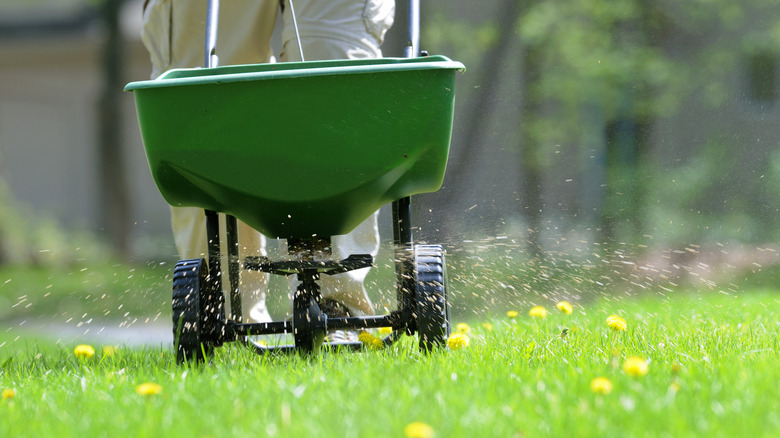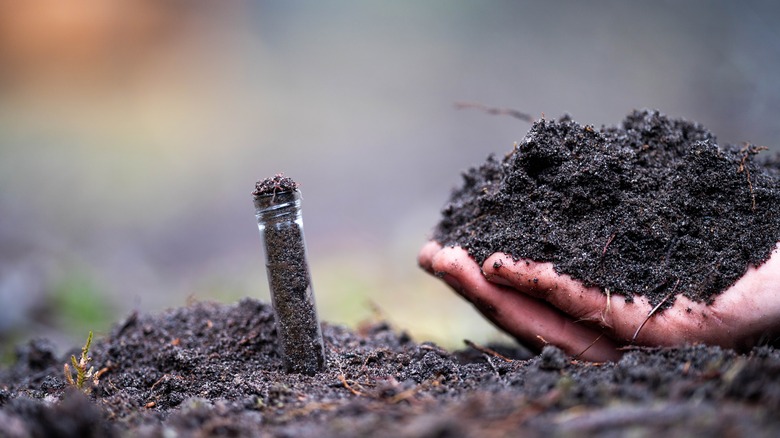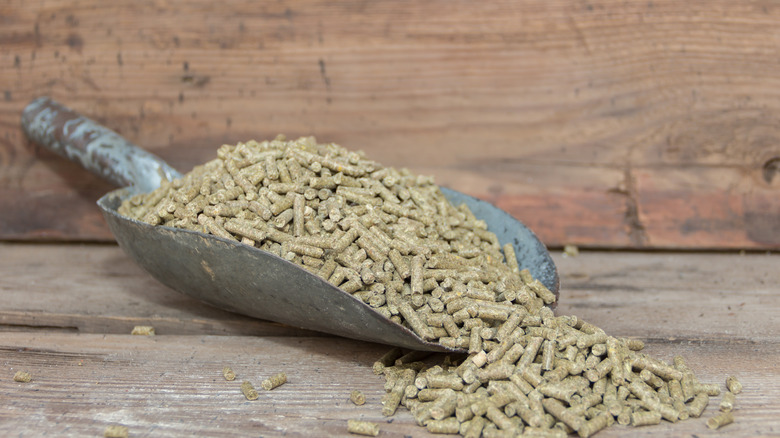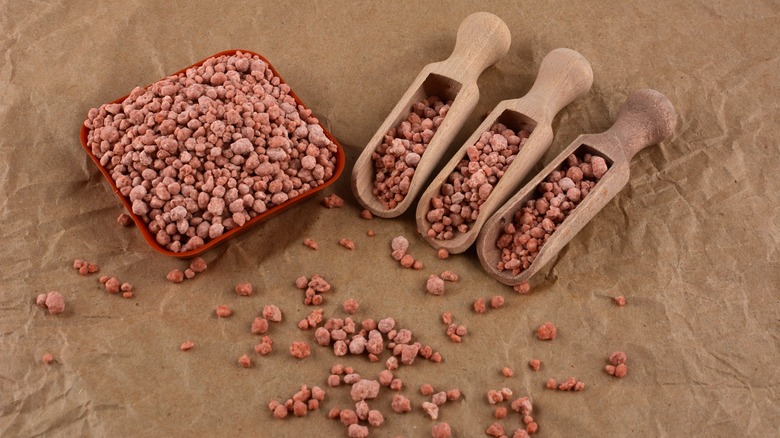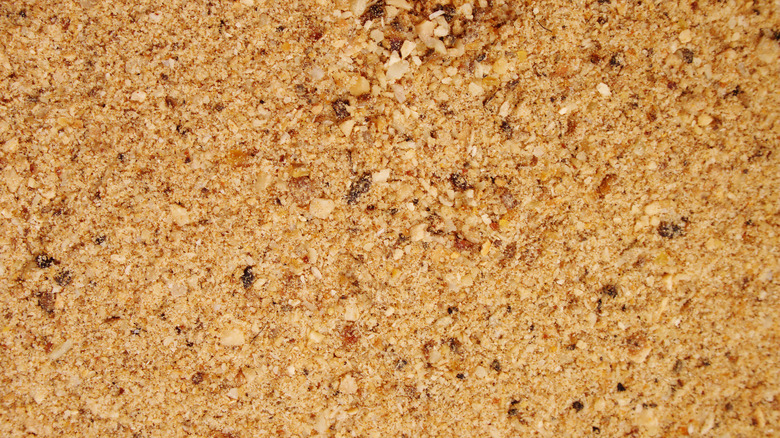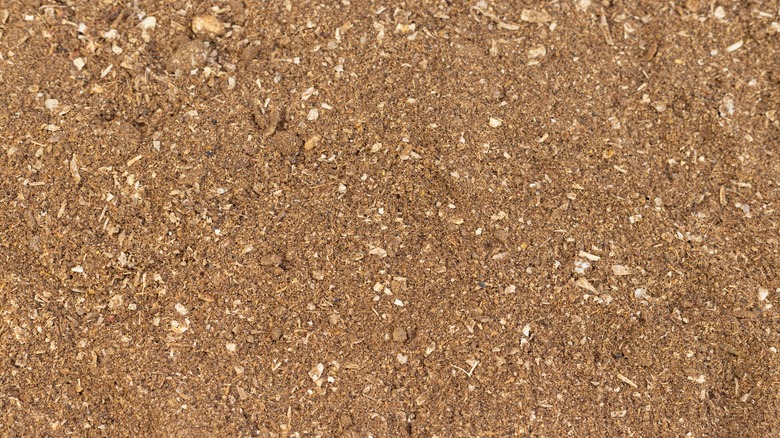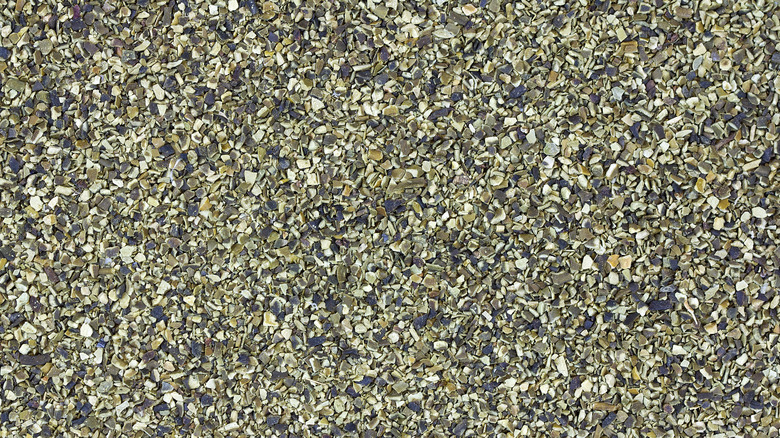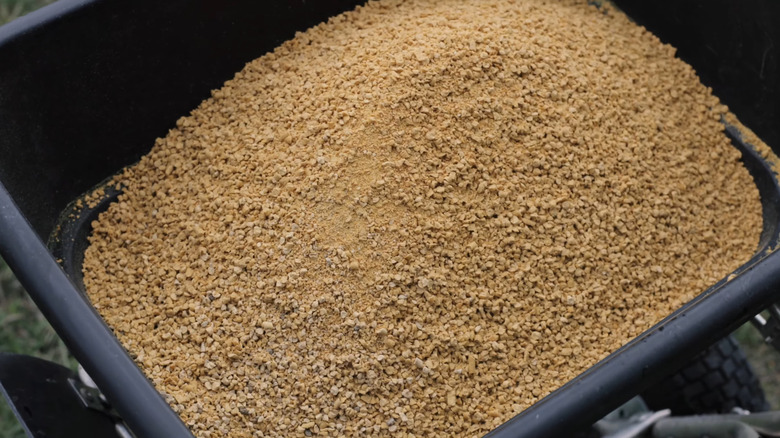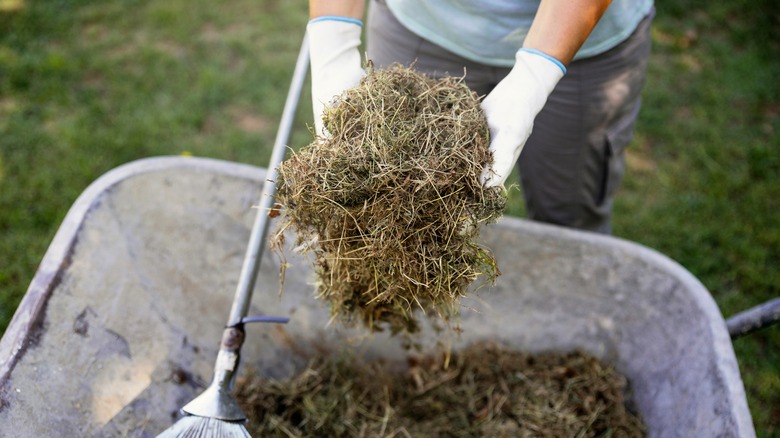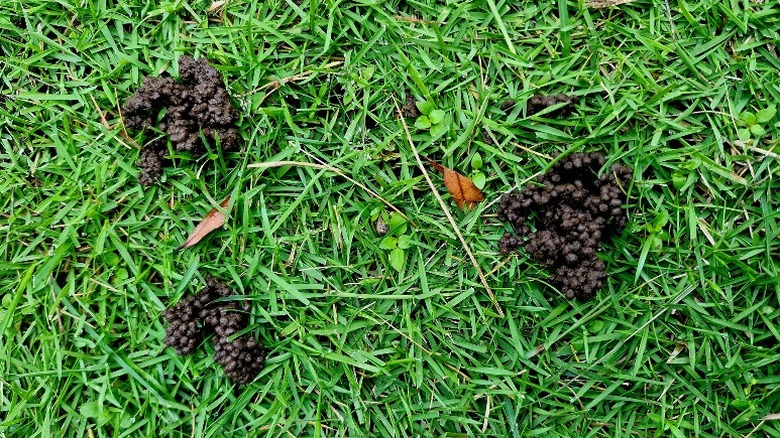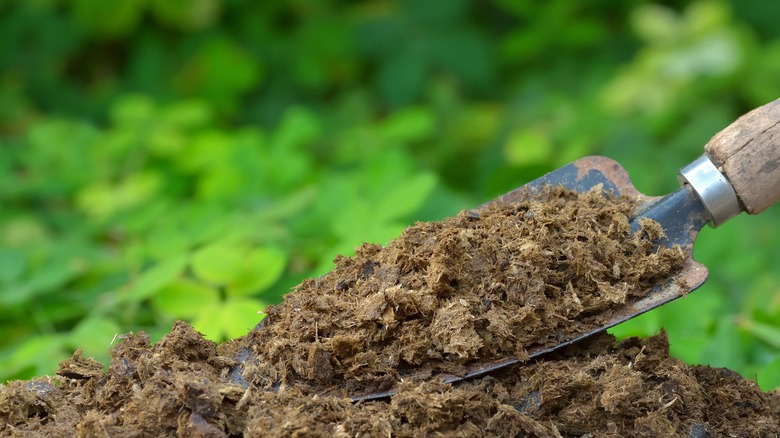8 Natural Ingredients That Provide Your Lawn With The Nutrients It Needs (& 1 To Avoid)
Sometimes, there's nothing more satisfying than looking out at your lawn. Surveying the land like some kind of medieval lord, taking in all its well-manicured beauty, and mentally congratulating yourself on a job well done. We wouldn't even judge you if a contented "Yep" and sigh slipped out, because you deserve that moment; keeping a consistently beautiful lawn is no easy task. So, if you're here because that medieval lordship moment is feeling a little out of reach with your patchy, weed-filled front yard, we get it and are here to help.
Sure, you could go the route of pumping your lawn full of chemicals to boost it with nutrients, akin to a steroid injection. However, like steroids, chemical fertilizers are a quick fix that can have unwanted consequences. Most manufactured fertilizers are derived from petroleum or natural gas, contributing to carbon emissions, greenhouse gases, and contamination of waterways via runoff.
Excessive chemical fertilizer use can also hurt your lawn in the long run, potentially burning the roots, increasing thatch, and making it more sensitive to heat and drought. Trying to supercharge grass with too many synthetic nutrients can also cause it to grow too lush too quickly, and the resulting sappy growth and weak tissue is more likely to attract pests. In contrast, natural sources of fertilizer can supply your turf with nutrients while also adding organic matter, thereby improving soil structure and water retention, and fostering a robust microbial ecology — all of which will set your lawn up for success. Here are eight of the best natural nutrient sources for turf, plus three commonly used fertilizer options you may want to pass on.
First get a soil test
Before you start crushing bones into meal or stealing your rabbit's food pellets, let's get a soil test done to know what you're working with, as adding too much or too little of what your lawn needs could be problematic. Despite sounding super scientific (which they are), soil tests are inexpensive and immensely beneficial, so don't skip this step.
Most garden centers, home improvement stores, universities' agricultural departments, or county Cooperative Extension services will offer a soil testing kit that includes lab work for a small fee. Depending on the test, you'll take soil samples from one or multiple areas and mail your kit in for analysis. In about two weeks, you'll receive a report that tells you the soil's pH, possible lime needs, cation exchange capacity or CEC (this measures the soil's level of negative charge, which allows it to hold and supply nutrients), and the levels of major elements like potassium, phosphorous, magnesium, and calcium. Some kits may offer results for organic matter content and texture (which determines how much clay, sand, and silt there is), as well as the levels of iron, copper, zinc, manganese, nitrogen, and salts. This may cost extra and isn't offered by all labs. Also, unless you're trying to fix a specific problem, testing for these parameters could be overkill; the most important lawn nutrients are nitrogen, potassium, and phosphorous. Nitrogen in the soil isn't always a useful indicator, and nitrogen application is often determined by how much the grass is likely to consume.
Finally, let's talk about when to fertilize. Researchers found that turf grass bulks up its roots in the fall so that the blades are ready to go after the spring thaw. Shoot for adding fertilizer between September and November for maximum efficacy.
Use alfalfa pellets as a balanced slow-release fertilizer
Okay, so you've done your soil test and are ready to add some goodies to your lawn. Let's get started with a balanced, light fertilizer that's effective but can't do a lot of damage if you go overboard: alfalfa pellets. Yep, the same granules you feed your pet rabbit is also an organic fertilizer that has many benefits in the garden. Alfalfa pellets contain an average of 5% nitrogen, 1% phosphorous, and 2% potassium, making it a good starter fertilizer that can be used regularly in your lawn care routine. Plus, alfalfa contains a long-chain alcohol known as triacontanol that acts like a natural growth stimulant.
Alfalfa pellets work as a slow-release fertilizer, so these are for the long-game strategy. For every 100 square feet of lawn, you will need to apply anywhere between 2-5 pounds, which works out to about 0.02-0.05 pounds for every square foot. Because they're a slow-release source of nutrients, there isn't too much risk of burning with alfalfa, but to be safe, you can always start at the low end of this recommendation.
Use blood meal for nitrogen
It may sound icky, but it's not as gross as you think, and its benefits make blood meal well worth the temporary horror movie addition to your yard. Blood meal is derived from slaughterhouse waste and comes in the form of dried pellets. It's a nitrogen powerhouse that delivers 10% nitrogen and 1% phosphorous and does not even waste its time with potassium (0%). It's considered one of the highest sources of non-synthetic nitrogen available, so if your soil's nutrient content is severely lacking, blood meal is one of the best natural fertilizers for your lawn.
However, there are cons to using it. Blood meal is high in ammonia which could burn your lawn if excessively applied – so only use it if you need a nuclear nitrogen option. It can also get expensive at garden centers, so you might want to price shop first. To incorporate blood meal into your lawn's soil, apply a rate of 5-10 pounds for every 100 square feet of grass, preferably veering on the lower end to reduce the chance of root burn. Blood meal will take anywhere from one to four months to fully release its nitrogen supply; if you live in colder climates, expect to lean toward a longer timeline since the microorganisms that break it down will be less active in colder temperatures.
Use bone meal for phosphorous
Bone meal is a little tricky to use but getting it right can make a world of difference. It's incredibly high in phosphorous, clocking in at 15%, with 3% nitrogen, and 0% potassium, respectively. Phosphorous allows plants to accumulate and move energy to roots, leaves, flowers, and fruits, and promotes faster growth. So, if your grass has been slow to grow and your soil report shows low phosphorous, there you go. Like blood meal, bone meal takes anywhere from one to four months to fully release its nutrients, dependent on the soil's temperature so keep that in mind.
That said, bone meal requires some extra analysis of your basic soil report. Researchers at Colorado State University found that bone meal was only effective at delivering phosphorous if the soil had a pH level below 7.0 (neutral), meaning it had to be acidic. Not to worry, though, as there are easy ways you can make your soil more acidic. To successfully fertilize with bone meal, apply about 10 pounds for every 100 square feet of lawn.
Use fish meal as a balanced lawn fertilizer
Fish meal is a fertilizer with a good range of the three major nutrients your lawn needs. It's hard to be specific about exact levels and time release, as amounts change based on where the fish was sourced and even which catch it's from. However, nutrient contents must be clearly labeled on organic fertilizer packaging so you'll be able to know what levels your fish meal has. Generally speaking, expect anywhere from 6-12% nitrogen, 3-7% phosphorous, and 2-5% potassium.
Fish meal is different from fish emulsion, so be sure you know which one you're buying since both are sold as fertilizers. Fish meal is a dried, ground powder derived from by-products of marine fisheries. Fish emulsion is a liquid concentrate of oil and water derived from processed fish remains, which are acidified using sulphuric acid and have an ungodly smell. To incorporate fish meal into your soil you'll need to do some math based on your soil's test results and the nutrient contents on your label. A rough baseline to start with is incorporating enough to ensure there is 1 pound of nitrogen for every 1,000 square feet. So if your fish meal has 10% nitrogen and your soil has none whatsoever, you would need 10 pounds of meal for every 1,000 square feet of lawn to raise nitrogen levels from 0-1 pound. It sounds confusing here, but having specifics from your label and soil test makes it much easier.
Use kelp meal for micronutrients
Kelp meal usually isn't given to lawns as an all-purpose fertilizer but added into other fertilizers to give grass a micronutrient boost. Kelp contains trace levels of the major nutrients (sometimes called macronutrients) but is full of minerals like calcium, magnesium, zinc, and iron. Farmers in coastal areas have used kelp for thousands of years to improve their soil conditions and its had proven effects boosting seed germination, growth, yield, and quality of certain crops in contemporary research studies. On an agricultural level, seaweed is effectively used to fertilize grasslands.
To leverage kelp on your lawn, apply 1 pound of meal into your preferred fertilizer for every 100 square feet of area you plan to fertilize. One thing to note: Kelp meal is a very slow-release fertilizer, taking at least four months before it breaks down, so don't expect a quick boost in micronutrients. However, this isn't a bad thing, as these are all secondary, anyhow.
Use corn gluten meal, but understand why
Corn gluten meal (CGM for short) is like the protein shake of lawn fertilizers. Not only does it have 10% nitrogen, but it's 60% protein, bro, and is a natural by-product from corn wet-milling. All that protein results in serious gains for your grass, making it thicker and less patchy so weeds have fewer places to set up shop and establish roots. To fertilize your lawn with corn gluten meal, apply 2-4 pounds of meal for every 100 square feet of lawn.
However, do not mistake corn gluten meal as a weed killer. In addition to being sold as a fertilizer, it's also marketed as a natural herbicide, but it seems like efficacy is limited to inhibiting root growth in seedlings. Since it's true that CGM helps thicken lawns, an argument could be made that this also then means it helps control weed germination rates. To reap the benefits of its weed-inhibiting properties, you need to apply corn gluten meal at just the right time, ideally, between 3-5 weeks before the weeds you're targeting will start to pop up. If you are intimately acquainted with the weeds that want to grow in your lawn, and when they germinate — CGM could be useful in combating them, but results may be limited the first time you use it. It also won't be able to muscle out already established weeds. Additionally, rainfall and watering reduce its efficacy as the targeted weed seedlings should be allowed to dry out with the CGM. So if you're going to use corn gluten meal to grow a healthy lawn without harnessing harsh chemicals, use it for the sick gains your grass will get and not for giving well-rooted weeds a haymaker.
Use grass clippings to give your lawn everything it needs
There's nothing more "we already have fertilizer at home" than using your lawn's own clippings as a nutrient source, but it's really useful! Grass clippings decompose quickly, releasing nitrogen and phosphorous back into the soil and giving beneficial microorganisms lots of organic matter to munch on. Plus, applying clippings (or simply letting them drop as you mow) is one of the best ways to break the recommendation of "fall fertilizing only," letting you meet your lawn's nitrogen requirements all season long. Besides being able to supply between 50-100% of most plants' nitrogen needs, clippings can also put 1.8 pounds of phosphorous back into the soil per every 1,000 square feet every year. Add mulched leaves in the fall to your grass clippings, too, and you've got even more phosphorous for free.
As you can imagine, it's not hard to reuse grass clippings as a mulch, but here are some tips to keep in mind. Smaller clippings decompose faster, so maintaining a weekly mowing routine will not only help keep your lawn tidy, but keep your clipping supply steady and the length short enough to nestle down between the grass, rather than layer on top like a blanket. Clippings over an inch in length should be removed as they can smother grass blades under them, causing damage. Rake wet clumps of clippings apart (especially if you mow after a fresh rain or watering), so they can dry out and the grass underneath isn't smothered. Finally, don't leave clippings lying if your lawn is struggling with a disease.
Worm castings could be helpful (or annoying)
Worm casts, also called vermicompost, are tiny clumps of soil ejected from the digestive tract of certain earthworm species (Aporrectodea and Lumbricus are the two main species, if you're curious). So yes, in a way, they are earthworm poop. Since earthworms eat a varied diet that includes decaying plant matter, manure, and soil organisms their excretions are full of essential minerals like magnesium, iron, copper, zinc, calcium, and sulfur. The exact ratios will vary, since vermicompost is an organic material that is influenced by what the worms feed on, so check your package's label for specifics.
Worm castings are gentle enough to be applied fresh and directly into the soil without worrying about fertilizer burn. While you can till castings into the soil, it's also fine to just spread them lightly over the top of your lawn. However, it's important to note that worm castings can get caught in shoe treads or lawnmower wheels, particularly in close-cropped lawns, which is why some people find them to be, as the Royal Horticultural Society politely puts it, "undesirable." If you're afraid of accidentally trampling over earthworm poop, there's also the option of creating a fertilizer "tea" by steeping ¼ cup of castings in a cheesecloth in 1 quart of water that has an air stone or fish tank bubbler in it (to keep the beneficial microbes in the castings alive). Put your brew in a sunny spot for 24-48 hours, then spray it over your lawn. If you've started worm composting kitchen scraps, you may have heard that the worm leachate, or "pee," can be used as a liquid fertilizer. However, it probably won't be as potent as a properly created batch of worm tea, and in poorly managed systems, may contain phytotoxins.
Skip using manure for your grass
Manure is controversial as it has been a staple of soil management forever, thanks to its high levels of organic matter and macronutrients that improve soil and feed grass. But there are too many variables out of your control that make it one of the least desirable fertilizer options in our eyes. First, if you take any advice from us, please let it be this: never use fresh manure. Fresh manure can introduce weed seeds, particularly if it is horse manure since horses have less aggressive digestive systems. If that's not enough, it also could transmit human pathogens like E. coli. While you might not think it's a problem since you're fertilizing your lawn and not a vegetable garden, remember that run-off happens and contamination is easier than you think.
Finally, compost made with biosolids (animal manure) has been found to often contain higher metal concentrations and soluble salt levels than composts made without. Adding both metals and salts to your soil increases its toxicity and reduces water absorption, making it harder for plants, like grass, to survive. There are so many viable natural fertilizers that don't contain possible weed seeds, pathogens, salts, or metals that it's definitely worth it to think twice before using manure as a fertilizer for your lawn.
